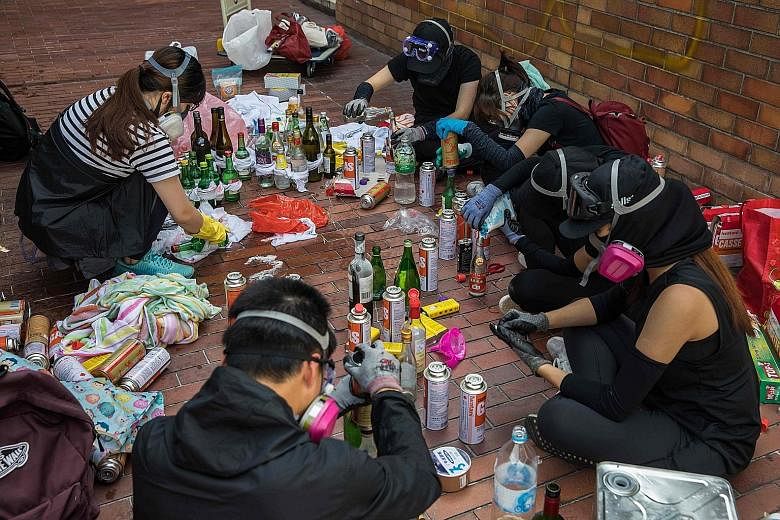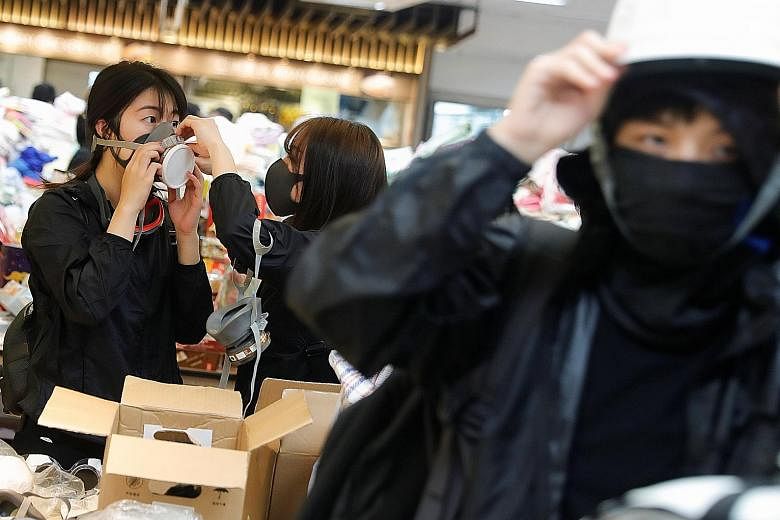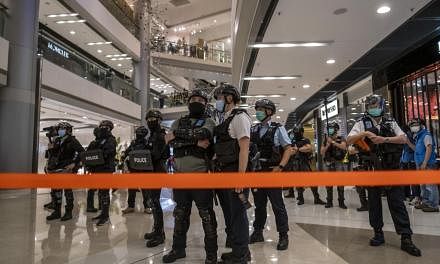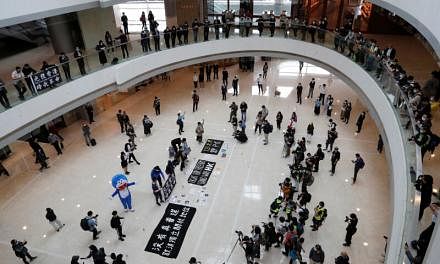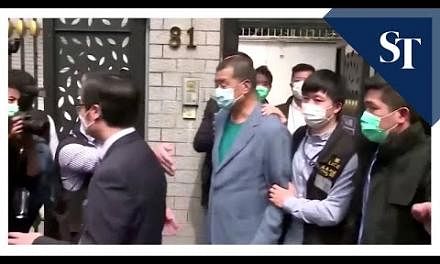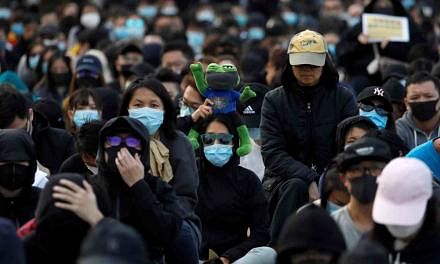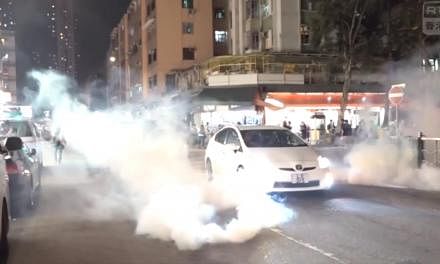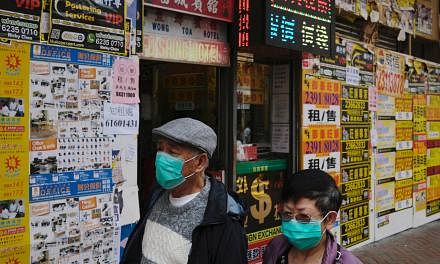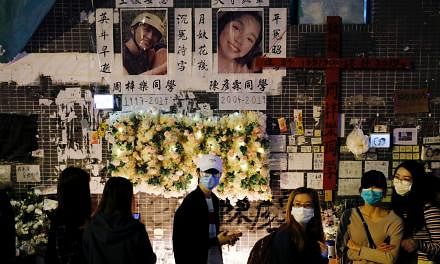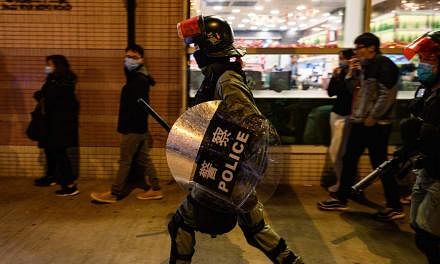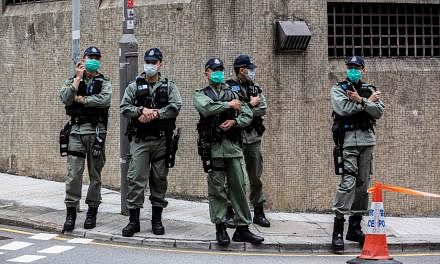HONG KONG • Under a November full moon, hundreds of young people dressed in black set about turning several of Hong Kong's top universities into fortresses, well-stocked with improvised weapons.
At City University of Hong Kong, protesters used ping pong tables, potted plants, furniture, sports equipment and bamboo to form a network of barricades to block roads and fortify the entrances to the student residence complex. Hundreds of protesters wearing gas masks and helmets tore up piles of paving bricks and ceramic tiles to hurl at police, while others stockpiled dozens of petrol bombs, distributing them to their forward positions.
Small groups sat chatting as they fashioned garden hoses and nails into spike strips to puncture car tyres.
At The Chinese University of Hong Kong (CUHK), between shifts hauling supplies to lecture halls and hammering bricks, hundreds hung around the graffiti-covered campus-turned-commune - napping wherever they could, checking their phones, enjoying the respite.
As the hours ticked by, there was a sense that things could flare up again at any moment.
With protesters beginning to wield bows and arrows looted from university sports offices and occupying improvised breastworks, the tactics now threaten to take the pro-democracy campaign to a new level of risk for all sides.
At CUHK, protesters have maximised every resource to make the campus a perfect citadel. The first-aid team has taken over the gymnasium: Nurses and volunteers man tables of creams and bandages while others sleep on the floor under sheets. A whiteboard keeps track of the injuries - calf wound, eye injury, ankle sprain - who's on duty, and emergency numbers.
The racetrack is the most popular sleeping quarters, although some protesters have erected tents on the inner field. A lecture hall operates as a supply centre, where piles of donations are at the students' disposal: clothes, blankets, battery packs, protective gear. A makeshift store offers candy, cup noodles and more.
Some here talk of "June 4" - a reference to the Tiananmen Square massacre of 1989, when China's ruling Communist Party gunned down hundreds, perhaps thousands, of pro-democracy demonstrators in Beijing.
"We can see the Chinese government and the Hong Kong police are trying to invade our school campus, our liberty, our future," said 17-year-old Damon, a high school student dressed in black and wearing knee pads, who was camped at CUHK.
"It has never been a fair war zone," said 23-year-old Josh, as he watched protesters practise shooting arrows at the Hong Kong Baptist University (HKBU).
"We have nothing, only masks, and the police have guns. We're only trying to defend ourselves."
Another protester said he had begun to throw bricks after seeing police attack demonstrators.
"We try every peaceful means but we fail," said Chris, 19, a student from the Hong Kong University of Science and Technology.
"We would probably throw petrol bombs and bricks because we don't want our friends to be injured," he said, breaking into tears as he described police crackdowns.
"I'm willing to die for Hong Kong."
The scene was repeated this week at nearly half a dozen campuses across Hong Kong, where demonstrators say they have been forced into taking a harder line by the government. Protesters have fortified parts of the campuses of Hong Kong Polytechnic University and the University of Hong Kong (HKU), in addition to CUHK, HKBU, and City University.
Until now, the anti-government protesters have used fast-moving, hit-and-run tactics to "be like water" and avoid arrest in clashes with police. The protesters say their non-violent efforts have been met by brutal police tactics, and their weapons are needed to protect themselves. Police have shot and wounded at least three protesters.
The protesters seem increasingly intent on forcing a showdown, as small raiding parties vandalise shops and block roads, tunnels and rail lines in widening areas around their campuses.
The authorities said protesters had turned CUHK into a "weapons factory", prompting a crackdown on Tuesday that left many people injured in fiery clashes. Police said flaming arrows, a signal flare and even electric saws had been wielded against officers. Protesters could be jailed for two years for assaulting a police officer, while "wounding with intent" could mean life, police said.
The city's Education Secretary chided university authorities over "riotous acts" on campuses. HKU president Xiang Zhang called on students not to provoke the police into entering the campus. "If there are any who are planning to do anything with serious consequences, such as actions likely to injure people, I appeal to them not to," he said.
But at City University, the dorm buildings echoed to the sound of protesters pulling up and heaping paving bricks to use as projectiles.
They knocked back cases of drinks and then filled the bottles with a mixture of oil and petrol. Protesters with less experience used plastic bottles to practise throwing. At one point, the operation got more organised as supplies of food, water and medical equipment were carried in.
"There are a lot of petrol bombs," said one 16-year-old school student who felt compelled to join the fray.
"It's set to be a good show."
